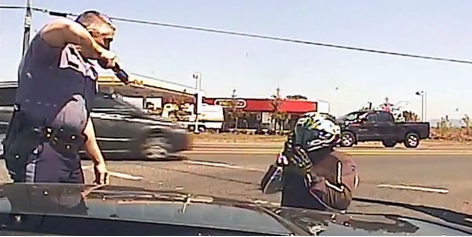“Without a doubt, the most controversial issue in American policing is the use of force by police officers. On too many occasions, we have seen newspaper headlines reporting that an individual has been brutalized or, worse yet, killed by the police. The consequences of excessive and deadly force have been severe, affecting both police organizations and the communities they serve.” (1)
Like other targeted communities, use of force issues are prevalent during many incidents involving members of motorcycle clubs or others fitting the biker stereotype. As a biker, it is important to understand how the courts define “excessive force” and what remedies are available to victims of unreasonable force.
Excessive Force Defined
Police officers in all states are granted authority to use force to accomplish lawful objectives. This includes arrest, entry to serve a warrant or make an arrest, and detention. (2)
“An officer may use only that force which is both reasonable and necessary to effect an arrest or detention. Anything more is excessive force.” (3)
The key phrase is “reasonable and necessary.” And since 1989, all use of force lawsuits are measured by standards established by the Supreme Court in Graham v. Connor. (4)
The Graham Precedent
Graham established the three pronged test to be used by lower courts to determine a test for reasonableness and necessity that generously favors law enforcement.
- First, what was the severity of the crime that the officer believed the suspect to have committed or be committing?
- Second, did the suspect present an immediate threat to the safety of officers or the public?
- Third, was the suspect actively resisting arrest or attempting to escape?
The Supreme Court said “the calculus of reasonableness must embody allowance for the fact that police officers are often forced to make split-second judgments–in circumstances that are tense, uncertain, and rapidly evolving–about the amount of force that is necessary in a particular situation.” “20/20 vision of hindsight” does not apply. (5)
Factors Justifying Additional Force
In the nearly 30 year history of the Graham test, courts have refined and applied a number of additional factors.
- When officers are outnumbered or confronted with particularly powerful suspects, additional force may be justified because the degree of threat posed by the suspect to officers and the public. (6)
- Courts have said force may be excessive depending on “the immediate availability of less-lethal tools.”(7) So if a police officer is carrying a taser and chooses to shoot you with his gun instead, it may be considered unreasonable depending on the severity of the threat posed by the suspect.
- An officer or agency cannot be held liable if less lethal means are not immediately Example: An agency’s failure to purchase/deploy a particular less-lethal technology. (8)
- A suspect’s history of mental illness, or level of impairment from alcohol or drugs, may justify additional force and should inform any threat (9)
Understanding “Resisting Arrest”
Resisting arrest occurs when a person interferes with a law enforcement officer’s attempt to perform a lawful arrest. Resisting arrest is often called “obstruction.”
Every state has slightly different laws which makes it critical that an individual charged with resisting arrest retain an attorney from their state. The crime can be a felony or a misdemeanor, depending on the severity of the actions of the person being arrested.
Misdemeanor resisting arrest (or obstruction) includes actions such as running and hiding from a law enforcement officer. Felony resisting arrest usually requires that a person either act violently toward the arresting officer or threaten to act violently. For example, striking or pushing an officer satisfies this requirement. A threat to strike an officer with an object in an individual’s hand would also satisfy this requirement.
Courts apply a three-pronged test to determine resisting arrest.
- Was the individual intentionally resisting or obstructing a law enforcement officer?
- Was the individual acting violently toward a law enforcement officer or threatened to act violently?
- Was the law enforcement officer lawfully discharging his official duties? Was the law enforcement officer properly engaged in the performance of official duties, such as investigating a crime or making a traffic stop? A law enforcement officer can be acting lawfully even when arresting the wrong person and even if the charges are dropped or the defendant secures an acquittal at trial.
Resisting Unlawful Arrest
Historically, resisting unlawful arrest was legal in almost every state. Not so in the current day. Today, only Alabama, Georgia, Louisiana, Maryland, Michigan, Mississippi, North Carolina, Oklahoma, South Carolina, Tennessee, West Virginia, and Wyoming recognize the right of an individual to fight off unlawful arrest.
Federal precedent says citizens may resist unlawful arrest to the point of taking an arresting officer’s life if necessary.” (10) This premise was upheld by the Supreme Court of the United States in the case: John Bad Elk v. U.S. (11) The Court concluded:
“Where the officer is killed in the course of the disorder which naturally accompanies an attempted arrest that is resisted, the law looks with very different eyes upon the transaction, when the officer had the right to make the arrest, from what it does if the officer had no right. What may be murder in the first case might be nothing more than manslaughter in the other, or the facts might show that no offense had been committed.”
NOTE- Even in states where resisting unlawful arrest is legal, most experts highly advise against resisting even an unlawful arrest due to the potential legal and physical risks associated with resisting arrest.
Excessive Force And Motorcyclists
Recent cases involving motorcyclists and excessive force have ruled:
- Using a police vehicle to ram a motorcycle is considered excessive force even if the motorcycle is fleeing.
- Kicking a person off of a motorcycle can be considered to excessive force.
- Pleading guilty to a citation does not preclude an excessive force claim.
In January 2016, a federal jury in Oregon granted motorcyclist Justin Wilkens $500,000. Video shows Capt. Rob Edwards pursuing Wilkens in an unmarked Camaro, rear-ending his motorcycle, and then pointing a gun at Wilkens and kicking him in the chest. The sum covers the more than $180,000 in damages as well as more than $335,000 in attorney fees and court costs. The jury determined that Capt. Rob Edwards used excessive force. (12)
On April 15, 2012 Kevin Gaul of the Tinicum Township Police Department put his police car into reverse and struck Brian O’Donnell’s motorcycle in order to end a pursuit. O’Donnell crashed as a result of the collision, suffering a broken leg with an open fracture, lacerations to his head and feet and spinal injuries. After the incident, O’Donnell received a citation and ultimately, pled guilty to it. The U.S. District Court for the Eastern District of Pennsylvania ruled June 11, 2015 that the force used by Gaul was excessive. The court wrote, “The crime O’Donnell was arrested for was not severe….He did not pose a danger to Gaul….or to the public in general.”
The plaintiff was seeking $300,000 in this matter, comprised of compensatory damages, punitive damages, attorney’s fees and court costs, other relief the Court deems reasonable and just. (13)
Factors Justifying Deadly Force
The Court said there are three circumstances that justify the use of deadly force. The Supreme Court eliminated the “fleeing felon” rule over three decades ago.
- officer is threatened with a deadly weapon.
- officer has probable cause to believe that the suspect poses a threat of serious physical harm or death to the officer or to another.
- officer has probable cause to believe that the suspect has committed a crime involving threatened or actual serious physical harm or death to another The Court also noted that, when feasible, a warning should precede the use of deadly force. (14)
Options Available For Victims of Excessive Force
A victim of excessive force may have a viable lawsuit against the arresting officers and even the municipality that employs them because excessive force violates the 4th Amendment’s prohibition against “unreasonable seizures.”
A claim can be filed under the Civil Rights Act of 1871 (42 U.S.C. § 1983.) Section 1983 allows a victim to file a claim if the victim’s constitutional rights are violated “under color of law.” Importantly, an attorney may take your case on a contingency basis because Section 1983 claims allow for the recovery of actual and punitive damages in addition to attorney fees.
____________________________________________________________________________________
(1) (See Patrick Reynolds, Asst. Director-School of Criminal Justice, FDU Magazine Online, Summer/Fall 2006)
(2) See Freeman v. Gore, 483 F.3d 404 (5th Cir. 2007)
(3) Payne v. Pauley, 337 F.3d 767 (7th Cir. 2003)
(4) See Graham v. Connor, 490 U.S. 386 (1989)
(5) Graham v. Connor, 490 U.S. 386 (1989)
(6) See Sharrar v. Felsing, 128 F.3d 810 (3rd Cir. 1997)
(7) See Tom v. Voida, 963 F.2d 952 (7th Cir. 1992)
(8) See Estate of Smith v. Silvas, 414 F.Supp.2d 1015 (D. Colo. 2006)
(9) See Krueger v. Fuhr, 991 F.2d 435 (8th Cir.), cert. denied, 510 U.S. 946 (1993); Hunt v. County of Whitman, 2006 WL 2096068 (E.D. Wash. 2006)
(10) Plummer v. State, 136 Ind. 306.
(11) John Bad Elk v. U.S., 177 U.S. 529
(12) Associated Press, June 7, 2016
(13) Nicholas Malfitano, Penn Record, Jun. 19, 2015, 11:51am
(14) See Tennessee v. Garner, 471 U.S. 1 (1985)




